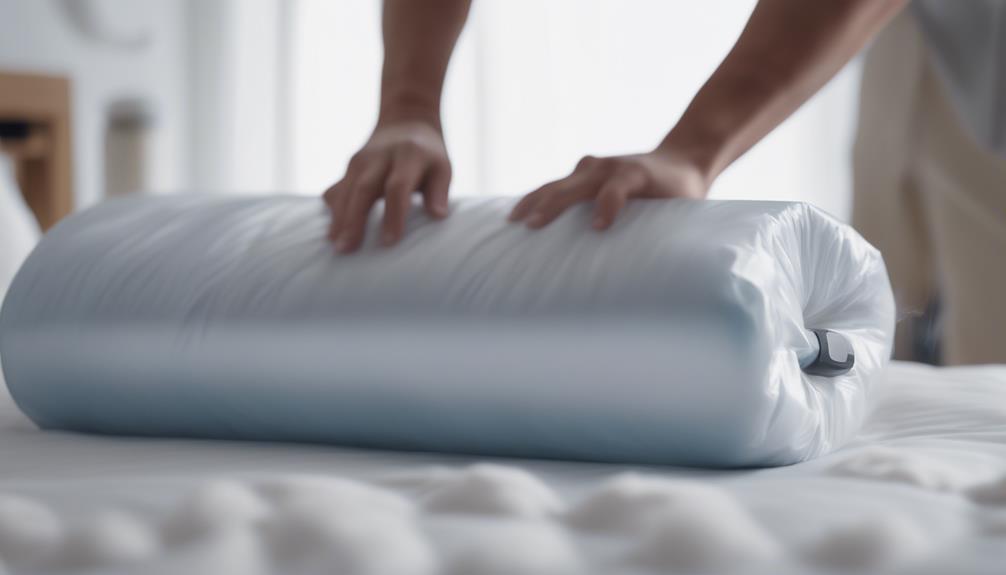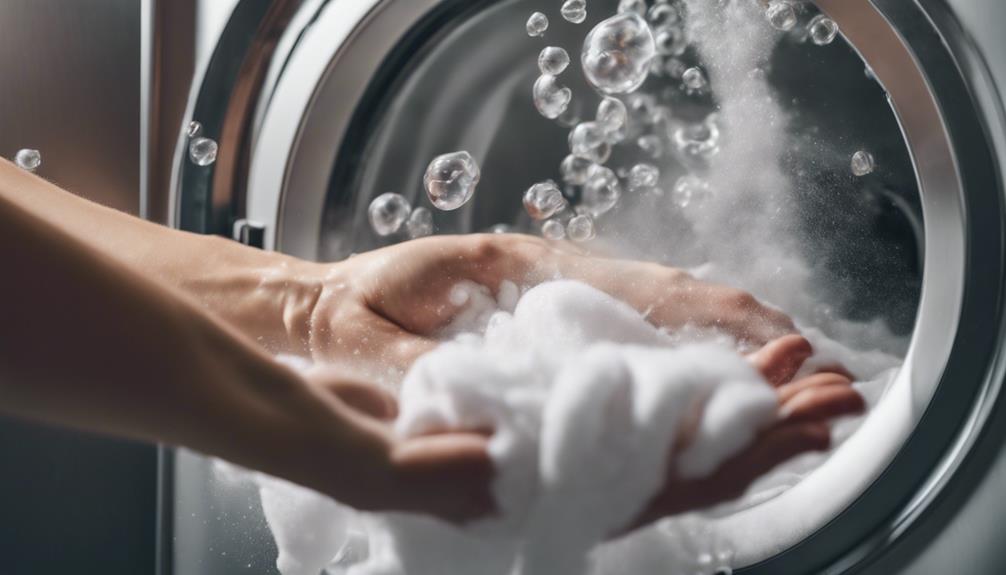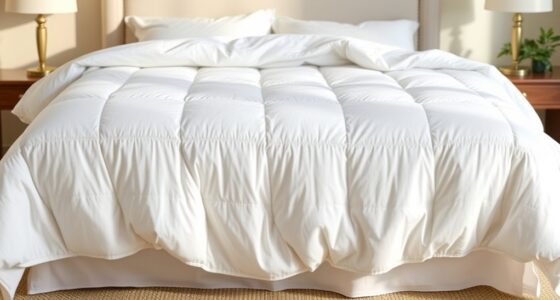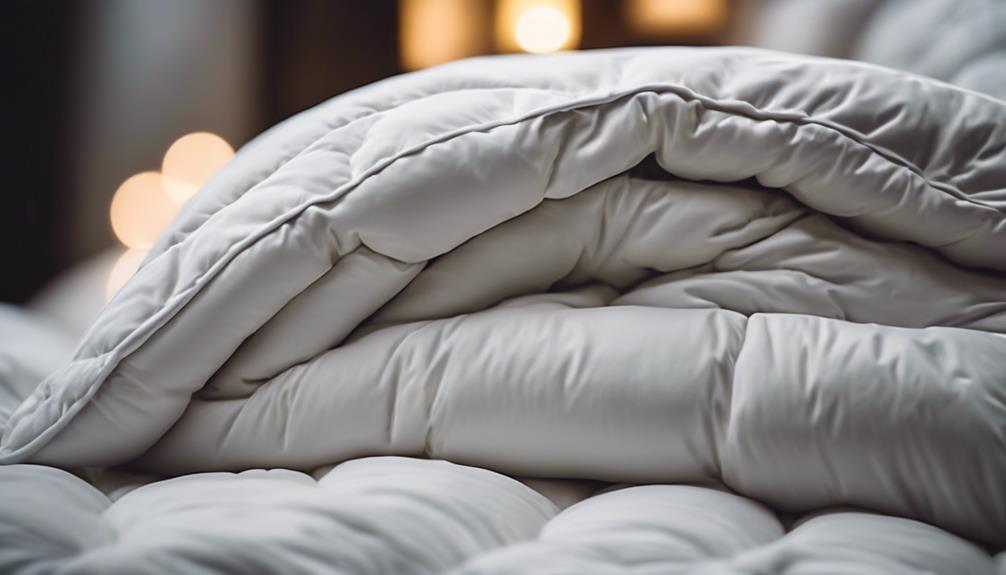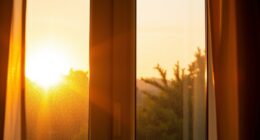Vacuum sealing a down comforter can harm its delicate down clusters, compromising fluffiness and insulation. This compression reduces loft, causing clumping and potential damage to the delicate down fibers. It may create a mold-friendly environment and impact the comforter’s quality and longevity. To maintain its effectiveness and quality, it’s best to prioritize proper breathing and maintenance of the comforter, follow specific care instructions, use breathable storage bags, and avoid compression. These practices can help preserve the comforter’s fluffiness, loftiness, and overall quality for an extended period.
Key Takeaways
- Vacuum sealing harms delicate down clusters and compromises fluffiness.
- Compression reduces loft, causes clumping, and damages down fibers.
- Avoid vacuum sealing to prevent mold, quill damage, and loss of loftiness.
- Opt for breathable bags to maintain natural loft and prevent compression.
- Proper storage practices preserve quality, effectiveness, and longevity of down comforters.
Potential Damage to Down Comforter
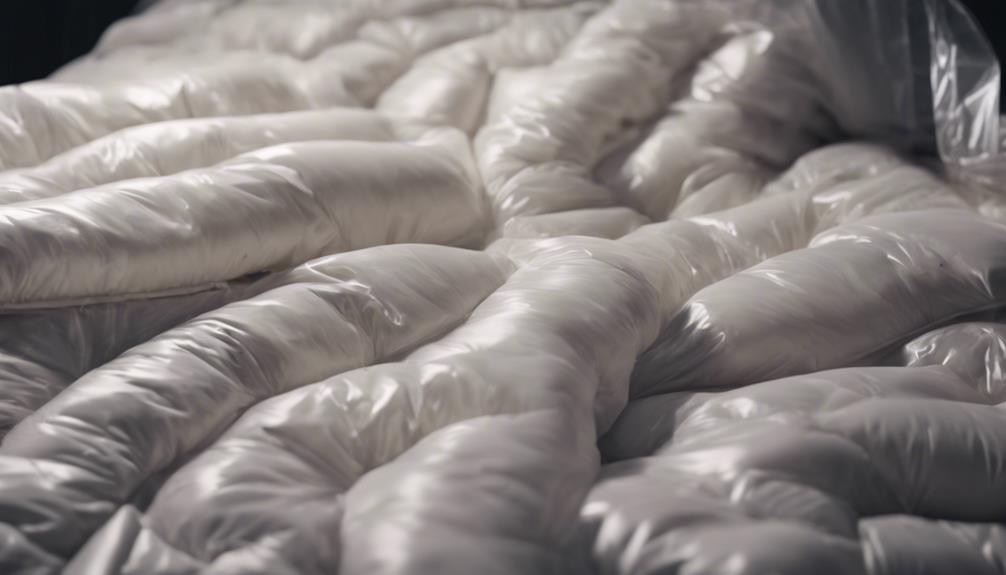
Vacuum sealing can harm the delicate down clusters inside a down comforter, compromising its fluffiness and insulation. When a feather duvet is placed in a vacuum storage bag and air is sucked out, the pressure created by the vacuum can compress the down clusters. This compression reduces the loft of the down, causing it to clump together and lose its ability to provide warmth effectively. The delicate structure of the down fibers can be damaged by the intense pressure of the vacuum, impacting the comforter's overall quality and longevity.
It is essential to avoid vacuum sealing down comforters to preserve their loft and insulation properties. By maintaining the natural fluffiness of the down clusters, the comforter can effectively trap air and create a layer of warmth. Instead of using vacuum storage bags, consider storing your feather duvet in a breathable cotton or linen bag to protect it from dust and moisture while allowing the down to remain fluffy and fully functional.
Compression of Delicate Down Fibers
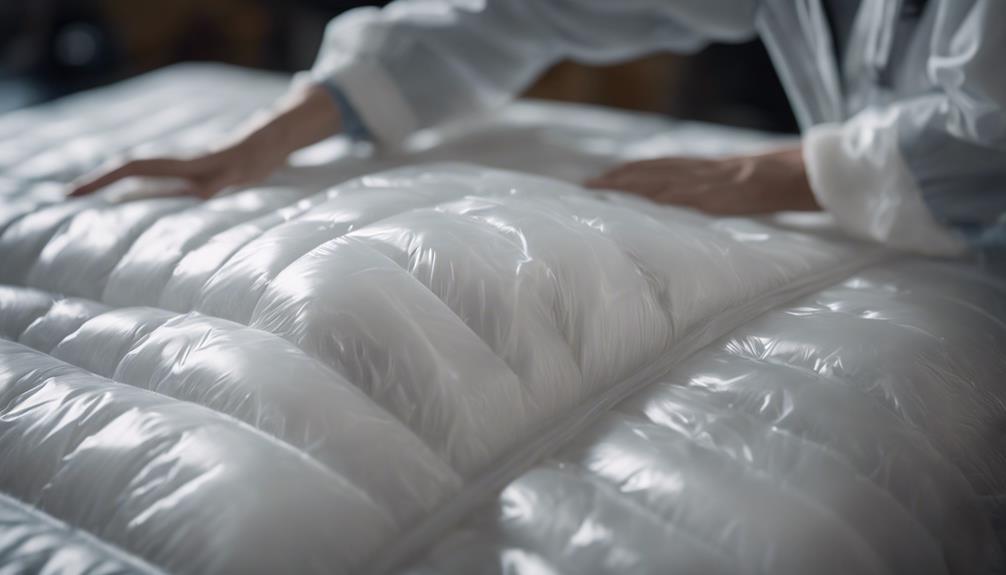
Under pressure, delicate down fibers in a comforter can compress, potentially compromising their loft and insulation properties. When a down comforter is vacuum sealed, the external force squeezes the fluffy down clusters together, causing them to lose their natural loftiness. This compression can lead to the down fibers clumping together, reducing the comforter's overall fluffiness and softness. Additionally, when down fibers are compressed in a vacuum-sealed bag, they may lose their ability to effectively trap air, which is essential for providing insulation and warmth.
The vacuum sealing process can also result in uneven distribution of the down within the comforter. This uneven distribution affects the comforter's ability to provide consistent warmth and comfort across its entire surface. Over-compression of the delicate down fibers in a vacuum-sealed bag can further compromise the quality and longevity of the comforter, potentially shortening its lifespan and diminishing its overall performance. It's essential to take these factors into account before vacuum sealing a down comforter for its best performance and longevity.
Impact on Comforter Fluffiness
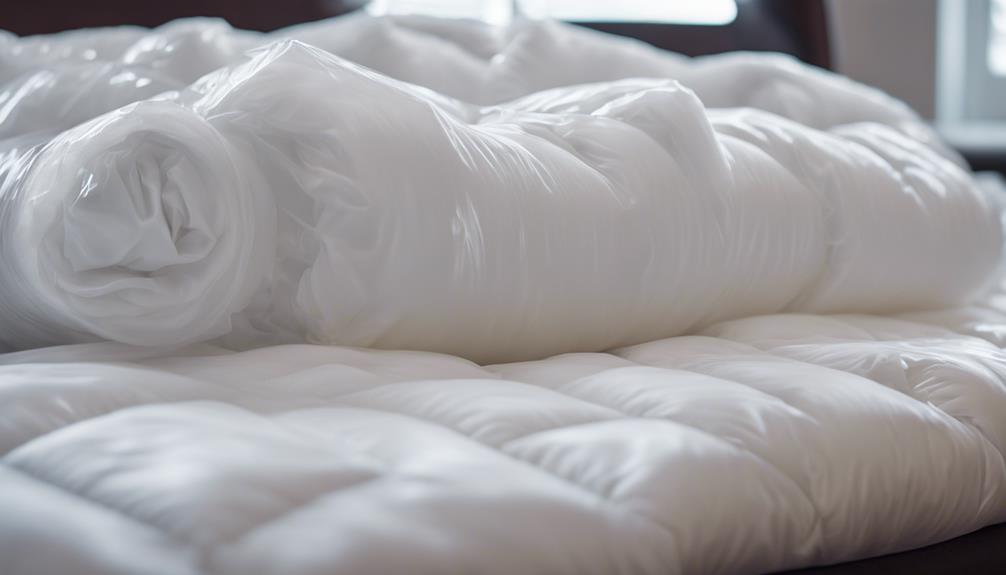
Maintaining the fluffiness of a down comforter is important for ensuring its comfort and warmth retention. When contemplating the impact of vacuum sealing on comforter fluffiness, it's essential to grasp the potential consequences. Here are some key points to keep in mind:
- Compression: Vacuum sealing can compress the feathers within the comforter, leading to a loss of fluffiness.
- Warmth: Compressed feathers may affect the comforter's ability to provide ideal warmth and insulation.
- Clumping: Squashing a down comforter in storage bags can cause clumping and uneven distribution of feathers, further impacting its fluffiness.
- Comfort: The loss of fluffiness can noticeably affect the overall comfort and coziness of the comforter.
- Mold Risk: Vacuum-sealed storage bags can create a conducive environment for mold growth, potentially compromising the comforter's quality.
Taking these factors into account, it's advisable to avoid vacuum sealing down comforters to preserve their original loft and effectiveness.
Downsides of Vacuum Sealing
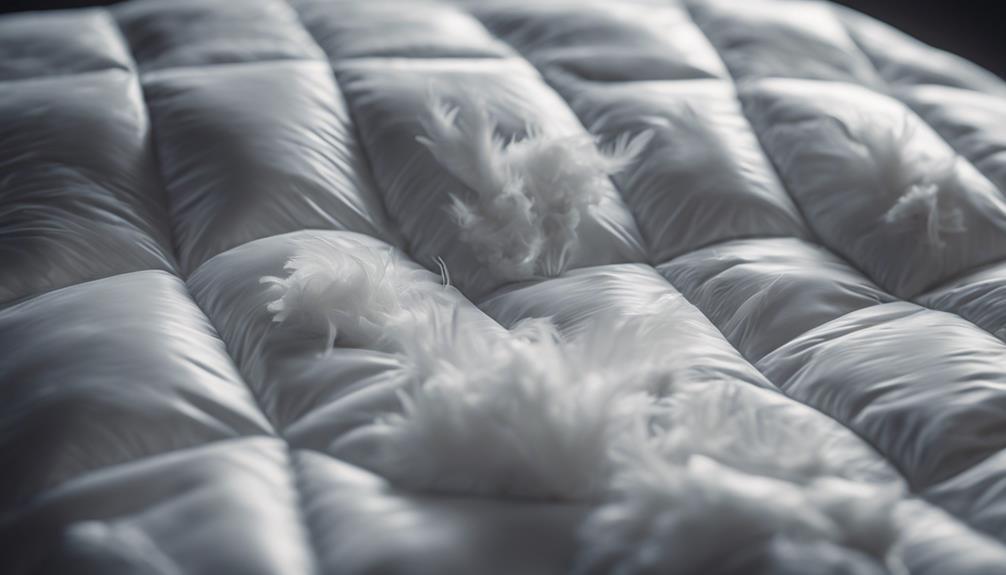
Excessive compression through vacuum sealing can significantly diminish the fluffiness and quality of down bedding. While vacuum bags can save space, they may not be the best choice for storing down comforters or pillows. When down is compressed too tightly, it loses its loft, reducing its ability to insulate effectively. This compression can also lead to the down clumping together, ruining the comforter's original fluffiness. In addition, the delicate quills in full feathers can snap when compacted in a vacuum seal, potentially damaging the bedding.
To further illustrate the downsides of vacuum sealing down bedding, consider the following table:
| Downsides of Vacuum Sealing |
|---|
| Diminished Fluffiness |
| Reduced Insulation |
| Clumping of Down |
| Risk of Quill Damage |
Additionally, vacuum sealing can create a sealed environment that may promote the growth of mold and mildew in the bedding, potentially causing health issues and further damaging the bedding. It's important to weigh the benefits of saving space against the potential downsides before vacuum sealing your down comforter.
Importance of Comforter Breathing
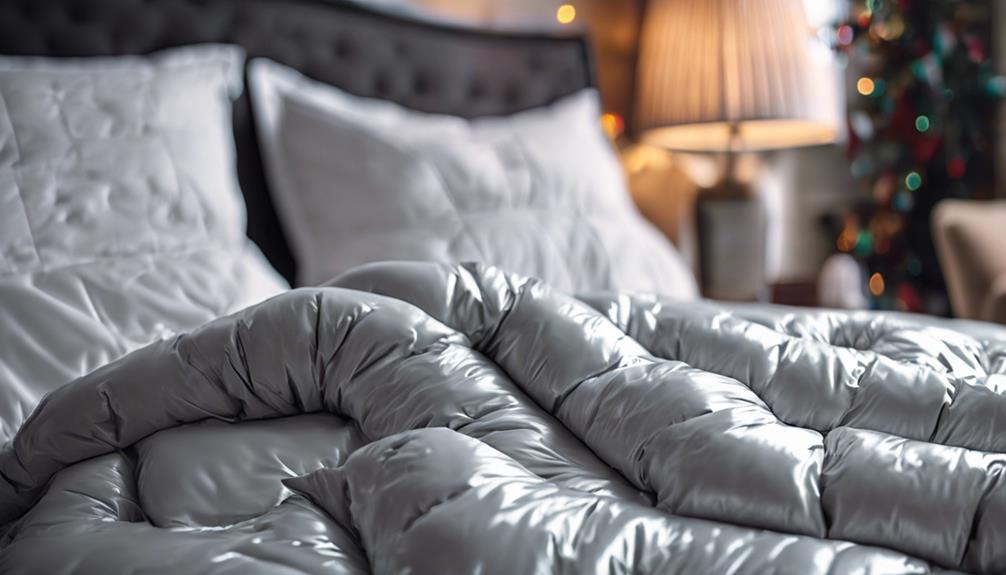
Proper air circulation is essential for maintaining the quality of a down comforter. Allowing the comforter to breathe helps preserve its insulation properties and fluffiness.
Air Circulation Benefits
Breathing is important for a down comforter to prevent moisture buildup and maintain its quality. Proper air circulation plays a significant role in ensuring that the fluffiness and loft of the down filling are preserved.
Here are some key benefits of air circulation for your down comforter:
- Prevents moisture buildup, mold, and mildew.
- Maintains the fluffiness and loft of the down filling.
- Helps prevent musty odors and loss of insulation properties.
- Preserves the quality and longevity of the comforter when stored in a bag.
- Prevents the growth of bacteria and maintains freshness.
Ensuring adequate air circulation is essential for keeping your down comforter in top condition.
Down Insulation Preservation
Moving on from discussing the benefits of air circulation for a down comforter, it's essential to emphasize the importance of allowing the comforter to breathe for preserving its down insulation. When considering storage options, it's imperative to select breathable solutions that promote airflow.
By allowing the comforter to breathe, you help maintain its loft and insulation properties. Avoid vacuum sealing, as it can compress the delicate down, leading to decreased fluffiness and warmth. Storing comforters in breathable containers or cotton bags can help preserve the quality and longevity of the down insulation.
Maintaining Comforter Fluffiness
Ensuring sufficient airflow for your down comforter is essential for maintaining its fluffiness and overall quality. Proper breathing allows the comforter to stay fresh and perform at its best.
Here are some key points to keep in mind:
- Breathing is Crucial: Good airflow prevents moisture buildup and mold growth.
- Prevents Damage: Allowing the comforter to breathe maintains its loft and insulation.
- Maintains Fluffiness: Air circulation prevents the down clusters from getting compressed.
- Preserves Quality: Regularly airing out the comforter can extend its lifespan.
- Avoids Odors: Proper ventilation helps eliminate musty smells and keeps the comforter fresh.
Clumping of Down Fibers
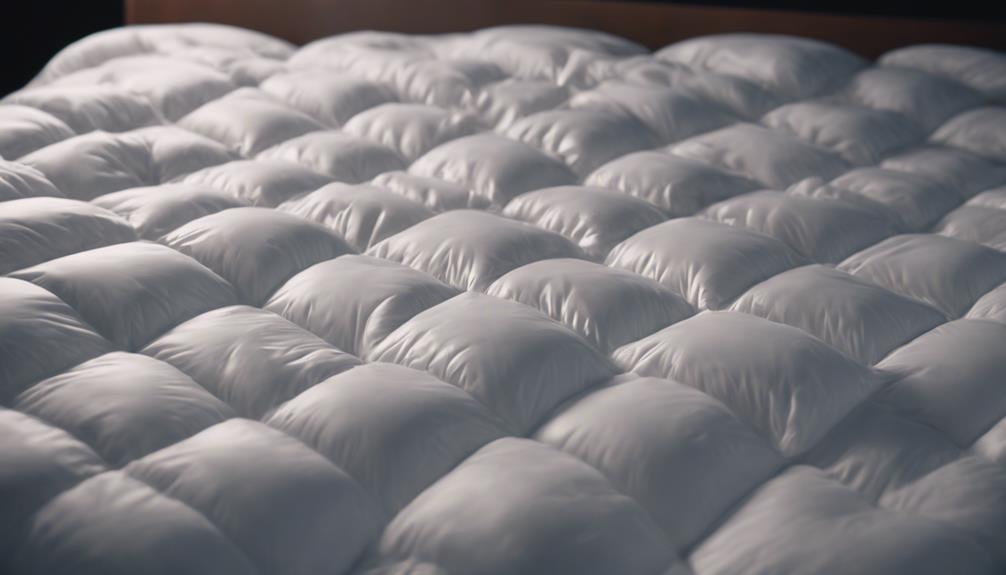
When down fibers in a comforter clump together, it can lead to issues like uneven distribution and decreased fluffiness. To prevent this, it's important to regularly pat, shake, and air out the comforter.
Additionally, using dryer balls during the drying process can help break up clumps and maintain even distribution.
Preventing Down Clumping
To prevent down clumping in your comforter, gently shake and pat the bedding to evenly distribute the down fibers. Here are some additional tips to help maintain your bedding:
- Use a low-heat dryer and dryer balls to break up clumps and restore fluffiness.
- Regularly flip the comforter to guarantee even distribution of down filling.
- Avoid over-compressing the comforter to prevent clumping of down fibers.
- Pat different parts of the comforter to evenly distribute the down and prevent clumps.
- Store the comforter in a breathable bag or container to maintain its loftiness.
Maintaining Fluffiness
After properly shaking and patting your down comforter to disperse any clumps, the next step in maintaining its fluffiness is to take into account the impact of regular use and care practices.
It's vital to keep your down comforter clean and dry, as moisture can lead to clumping of the down fibers. Different types of bedding may require varying maintenance routines, so it's important to follow specific care instructions provided by the manufacturer.
Loosening the down fibers through gentle patting and shaking helps maintain even distribution and prevents clumping. Using a low-heat dryer or dryer balls can aid in breaking up clumps and restoring fluffiness.
Regularly flipping the comforter and applying gentle pressure can also help maintain its original shape and prevent compression-induced clumping.
Best Storage Practices for Comforters
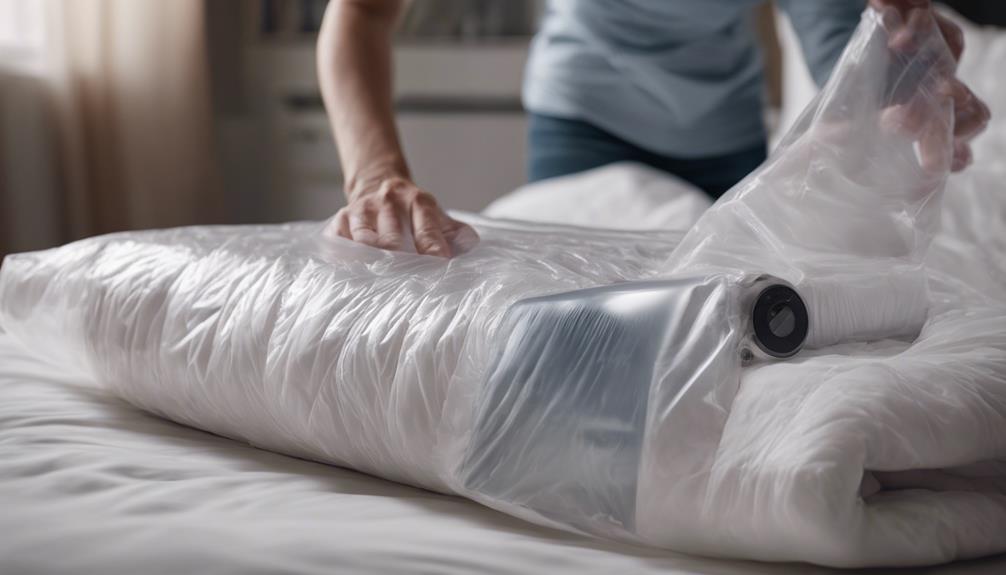
How can we guarantee the longevity and quality of our comforters during storage? When it comes to storing comforters, especially down ones, proper care is essential to maintain their integrity. Here are some best storage practices to make sure your comforter stays in top condition:
- Avoid stacking anything on top: Placing heavy items on top of your comforter can compress the delicate down filling, leading to loss of fluffiness and insulation.
- Keep it completely dry: Moisture is the enemy of down comforters as it can promote mold and mildew growth. Make certain your comforter is completely dry before storing it to prevent any damage.
- Opt for breathable cotton bags: Using breathable storage bags made of cotton allows airflow, preventing musty odors and mildew buildup.
- Store in a cool, dry place: Choose a storage location away from moisture and pests to safeguard your comforter from potential damage.
- Avoid compressing the comforter: To maintain the fluffiness and loftiness of your comforter, avoid compressing it tightly during storage. Allow it to breathe and retain its natural loft.
Preserving Quality and Fluffiness
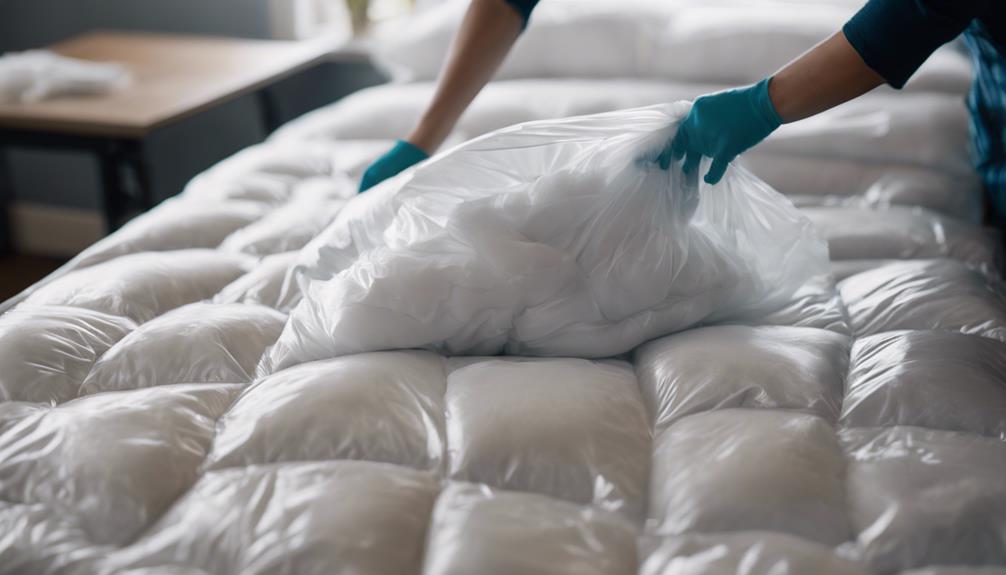
Preserving the quality and fluffiness of a down comforter is vital for maintaining its insulation properties and longevity. When it comes to storing a down comforter, it's important to avoid vacuum sealing. This method can compress the feathers, reducing the comforter's effectiveness in keeping you warm.
By compressing the down bedding, you risk ruining its original fluffiness and potentially damaging the feathers inside. Instead, opt for properly storing your down comforter in breathable bags. These bags allow the feathers to retain their natural loft and prevent compression that can harm the insulation properties of the comforter.
Using non-compression storage bags specifically designed for down comforters is a wise choice to guarantee the longevity and quality of your bedding. Remember, maintaining the fluffiness of your down comforter through proper storage practices won't only preserve its effectiveness but also extend its lifespan for years to come.
Frequently Asked Questions
Can You Vacuum a Down Comforter?
Yes, vacuum sealing a down comforter isn't recommended. The delicate down clusters can be damaged, reducing their fluffiness and effectiveness.
The compression from vacuum sealing can break the quills of the down feathers, affecting their insulation properties. It can also lead to clumping and uneven distribution of down within the comforter.
To maintain the loft and effectiveness of a down comforter, it's best to use proper storage bags or containers that allow the comforter to breathe.
What Is the Best Way to Store a Down Comforter?
Storing a down comforter properly is essential to maintain its quality.
We recommend placing it in a large cotton bag to allow breathing and prevent damage. Avoid compressing the feathers to keep its fluffiness and insulation intact. Never stack items on top of the comforter to prevent flattening. Vacuum sealing in fully compressed bags should be avoided as it can harm the feathers.
These storage methods help preserve the comforter's loft, warmth, and effectiveness.
Is It Okay to Vacuum Seal a Puffer Jacket?
Vacuum sealing a puffer jacket can compress the insulation, diminishing its warmth and fluffiness. It's best to avoid vacuum sealing puffer jackets to maintain their insulating properties and longevity.
Instead, opt for proper storage in a breathable bag to preserve their quality. Remember, compressed insulation in a vacuum-sealed puffer jacket may not provide adequate warmth, so it's important to store them correctly.
How to Vacuum Seal a Comforter?
To vacuum seal a comforter, choose a large storage bag. Seal it completely before attaching a vacuum cleaner to the valve.
Gradually remove air while patting the bag to evenly pack the comforter. Leave some air in, about 20-30%, to protect the filling. This method helps compress the comforter for storage without damaging the down.
Remember these steps for efficient vacuum sealing.
Can You Use the Same Method to Vacuum Seal a Down Comforter as a Regular Comforter?
Yes, you can use the same method to vacuum seal a down comforter as a regular comforter. However, it’s important to ensure that the comforter is completely dry before vacuum sealing. Check out our vacuum sealing a comforter article for more tips and tricks on how to properly vacuum seal your comforter for storage.
Conclusion
To sum up, when contemplating, it's crucial to take into account that vacuum sealing a down comforter may lead to potential damage, such as compression of delicate down fibers and loss of fluffiness.
It's essential to acknowledge the downsides of vacuum sealing, including the impact on comforter breathing and clumping of down fibers.
To preserve the quality and fluffiness of your comforter, it's best to follow proper storage practices that don't involve vacuum sealing.
Remember, a down comforter needs room to breathe and stay fluffy, just like a bird needs space to spread its wings.
